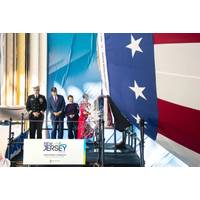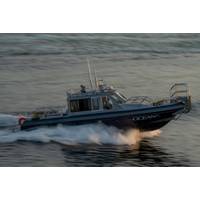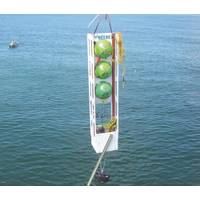
The Ocean Could Store Vast Amounts of Captured Carbon – But We Need Deep Ocean Sensors to Track the Effects
carbon dioxide from the atmosphere is now necessary for all pathways to keep global warming under 1.5 degrees Celsius (2.7 F). Beyond that, climate change’s impacts become increasingly dangerous and unpredictable.Because of its volume and carbon storage potential, the ocean is really the only arrow in our quiver that has the ability to take up and store carbon at the scale and urgency required.A 2022 report by the national academies outlined a research strategy for ocean carbon dioxide removal. The three most promising methods all explore ways to enhance the ocean’s natural ability to

Subsea Robotics: Aquanauts, Hydronauts, Roll Out
Networked Communications (WNC). Recent testing with Nauticus has included the ability of their WNC to dynamically adapt to provide the best performance in a given environment.Concurrently, Nauticus is building, through Diverse Marine in Cowes, UK, an 18 m, aluminum-hulled, SMART-Gyro (from Golden Arrow) stabilized USVs called Hydronaut, which will act as a transport, recharge and communication gateway for Aquanaut. Nauticus has an agreement with Diverse to build 20 Hydronauts, with the first two initially scheduled for completion in Q1 and Q2 2023. The rest are expected to include Jones Act compliant

HII’s New Medium Class UUV sports Kraken SAS
payloads as needed. Kraken's MINSAS provides out-of-the-box high-resolution, real-time onboard beamforming which supports embedded ATR, enabling smart autonomy features such as dynamic mission re-tasking based on contacts identified.Figure 2: Kraken MOSAIC taken from HII REMUS with MINSAS 60 (Red arrow indicates location of Fig. 3). Image courtesy Kraken Robotic

Tech File: Smartgyro Stabilization for Diverse Marine’s Hydronaut Vessels
A new 18-m craft for the Nauticus robotic navy fleet will be fitted with Smartgyro’s SG80 units for roll reduction in manned and unmanned operations.Golden Arrow Marine is supplying Smartgyro SG80 gyroscopic stabilization units to Cowes boatbuilder Diverse Marine for installation on its new 18-m Hydronaut vessels for Houston-based Nauticus Robotics.The Smartgyro SG80 is innovative in that it can be serviced, maintained and assembled directly inside the boat, suitable for both new builds and refits.Smartgyro’s UK Master Dealer Golden Arrow Marine has partnered with Nauticus Robotics, a

US Navy Submarine New Jersey (SSN 796) Christened
, especially to the 4,000 men and women whose hard work put New Jersey together,” said Mullen, adding that the nation must prevail in an ideological battle against an adversary it has not seen before.“The future USS New Jersey will be a critical — some say the most critical — arrow in our quiver,” he said.The company reached the pressure hull complete milestone in February, meaning that all of the ship’s hull sections were joined to form a single, watertight unit. This was one of the last major milestones before the christening, and is floated off to a pierside

Metal Shark Builds Custom Tender for R/V OceanXplorer
including a climate controlled cabin with air conditioning and heat, head with fresh water shower and tankless water heater, water maker filtration system, and a custom berth with IT rack beneath.Powered by twin Cummins QSB 6.7 550 HP diesel inboards mated to Hamilton HJ 292 water jets with Blue Arrow controls, the 38 Defiant demonstrates pinpoint maneuverability at all speeds, while the JETanchor system assists with station-keeping and also offers a “virtual anchor” mode. The choice of diesel power allows the tender to refuel off the mothership safely while eliminating the hazards

Sonar Images Show Historic Avro Arrow Discovery
A search team has recently unveiled images that show the first of nine Avro Arrow free-flight models believed to be sitting at the bottom of Lake Ontario. Search program organizers OEX Recovery Group held a press conference in Toronto last Friday to unveil sonar and underwater camera images that showcase a free-flight Avro Arrow model launched in a series of tests from 1954 to 1957 as part of the Avro Arrow design program. The free flight models were launched over Lake Ontario in a series of flight tests conducted in the 1950s as engineers developed the revolutionary Arrow, which

Kraken Set to Hunt for Avro Arrow Artifacts
Kraken to deploy its ThunderFish robot and AquaPix sonar during search for 60-year-old Avro Arrow aircraft models in Lake Ontario A new search mission will seek to locate nine Avro Arrow free flight models launched over Lake Ontario in a series of tests from 1954 to 1957. The missing models are one-eighth scale replicas of the famed Canadian flying jet, and were part of the final flight design tests done prior to the production of the Avro Canada CF-105 Arrow aircraft, often referred to as the Avro Arrow. The goal of the search is to discover the resting place of nine models, recover

SoCal Tech Focus: Global Ocean Design
. The company’s Beacon Board is a new idea in surface location devices. Using a pair of GPS receivers linked by a VHF radio, a surface recovery ship receives a direct range-and-bearing to a surface target, such as a lander returned to the surface. The bearing, in the form of a large red arrow pointing the way, and a numeric distance display, is an unambiguous means to determine the location of your target within a line-of-sight radius of up to 8 nautical miles of the ship. This recovery aid fits easily inside a glass or polystyrene spheres as small as 10” OD. It operates despite



 February 2024
February 2024





